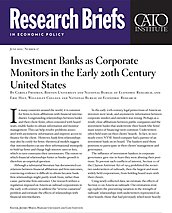Although a substantial literature has documented correlations between financial affiliations and firm outcomes, convincing evidence is difficult to obtain because bankfirm relationships might partly result from, rather than cause, particular firm outcomes. Our research utilizes a regulation imposed on American railroad corporations in the early 20th century to address the “reverse-causation” problem and estimate the effects of relationships with financial intermediaries.
In the early 20th century, legal protections of American investors were weak, and asymmetric information between corporate insiders and outsiders was strong. Perhaps as a result, close affiliations between public companies and the investment banks that underwrote their bonds (the firms’ main source of financing) were common. Underwriters often held seats on their clients’ boards. In fact, in 1910 nearly every NYSE-listed company had a partner of an investment bank on its board. The bankers used those positions to participate in their clients’ management and governance.
The influence of investment bankers in corporate governance gave rise to fears they were abusing their positions. To prevent such conflicts of interest, Section 10 of the Clayton Antitrust Act of 1914 prohibited the securities underwriters of railroads, then the largest and most widely held corporations, from holding board seats with their clients.
Using newly collected data, we estimate the effects of Section 10 on American railroads. Our estimation strategy exploits the preexisting variation in the strength of railroads’ relationships with underwriters represented on their boards: those that had previously relied more heavily on the securities underwriters on their boards were more severely affected by the regulatory change. The results indicate that the regulation undermined those railroads’ ability to finance valuable investment opportunities and to obtain external funds. Thus, although intended to eliminate conflicts of interest faced by financiers, Section 10 restricted their access to information and limited their role as monitors, ultimately harming the firms and investors the legislation was intended to protect.
Our analysis uses the fact that Section 10 was not implemented in 1914, but instead repeatedly postponed, going into effect only in 1921 when President Wilson vetoed a further postponement. Thus, Section 10’s timing is arguably exogenous to firm outcomes, and our findings are not confounded by the effects of the other antitrust provisions of the Clayton Act that were implemented in 1914. To avoid confounding effects from choices made by firms and banks in anticipation of the ultimate implementation of Section 10, our empirical framework compares the outcomes of railroads before and after 1921 by the strength of their affiliations with bankers in 1913.
We find that railroads with stronger relationships with their underwriters in 1913 experienced a decline in their investment rates, valuations, and leverage, as well as an increase in their average interest rates in the years following 1921. For most variables, the economic magnitudes of the estimates are relatively modest, but the effect on investment rates was large: a 28 percent decline relative to the mean 1920 rate. As a falsification test, we perform the same analysis on industrial corporations, many of which had strong affiliations with underwriters, but which were not subject to the prohibitions of Section 10. We find no effects of close ties to underwriters among those firms.
The prohibitions of Section 10 went beyond securities underwriting, encompassing other forms of self-dealing by railroad directors such as purchasing inputs from affiliated firms. We do find evidence that self-dealing in supply contracts may have harmed the railroads. However, our results regarding the affiliations with underwriters are robust to including controls for supplier interlocks. The authors of Section 10 also hoped to reduce the ability of banker-directors to facilitate collusion, since many bankers held multiple railroad directorships. Yet interlocks with competitors created by underwriters had no differential effects on firm outcomes following the implementation of Section 10, suggesting that the act had a negligible effect on anticompetitive practices.
Our work provides quantitative evidence of the costs that can be created by rules intended to address conflicts of interest. Section 10 of the Clayton Act was motivated by the perception that banker-directors engaged in selfdealing to profit from their positions at the expense of shareholders. Similar conflicts of interest may emerge in contexts as diverse as the presence of revolving doors between regulators and the entities they regulate, the conduct of related-party transactions by corporate directors, the choice of arbitrators in the brokerage industry, and the use of academic experts for determining grant funding. To prevent abuses, the legal systems of many countries sometimes subject those individuals or transactions to strict regulations. Yet these rules may also disrupt the flow of information that made the relationships valuable in the first place. Our results indicate that the information costs imposed by a rule that prohibits transactions in which there is a conflict of interest may have sizable negative effects on the parties they are intended to protect.
NOTE
This research brief is based on “Investment Banks as Corporate Monitors in the Early 20th Century United States,” by Carola Frydman and Eric Hilt, NBER Working Paper No. 20544, October 2014, http://www.nber.org/papers/w20544.

